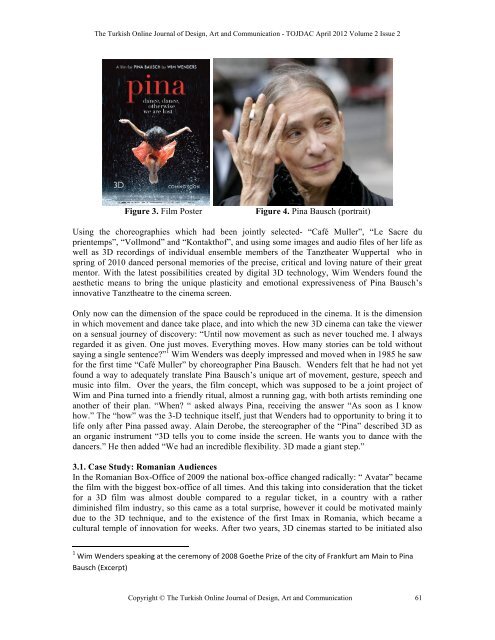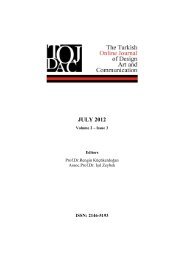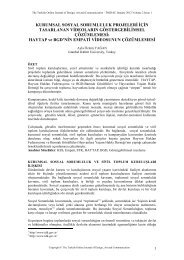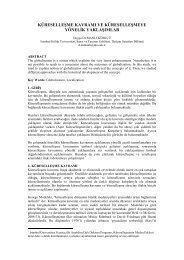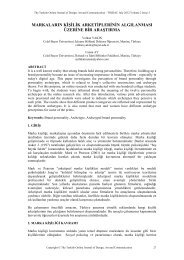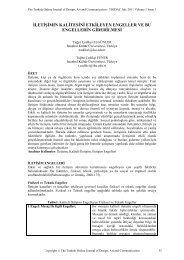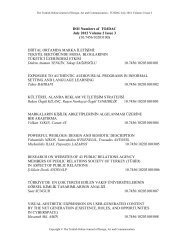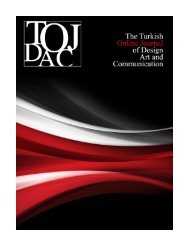aprıl 2012 - tojdac.org
aprıl 2012 - tojdac.org
aprıl 2012 - tojdac.org
You also want an ePaper? Increase the reach of your titles
YUMPU automatically turns print PDFs into web optimized ePapers that Google loves.
The Turkish Online Journal of Design, Art and Communication - TOJDAC April <strong>2012</strong> Volume 2 Issue 2<br />
Figure 3. Film Poster<br />
Figure 4. Pina Bausch (portrait)<br />
Using the choreographies which had been jointly selected- “Café Muller”, “Le Sacre du<br />
prientemps”, “Vollmond” and “Kontakthof”, and using some images and audio files of her life as<br />
well as 3D recordings of individual ensemble members of the Tanztheater Wuppertal who in<br />
spring of 2010 danced personal memories of the precise, critical and loving nature of their great<br />
mentor. With the latest possibilities created by digital 3D technology, Wim Wenders found the<br />
aesthetic means to bring the unique plasticity and emotional expressiveness of Pina Bausch’s<br />
innovative Tanztheatre to the cinema screen.<br />
Only now can the dimension of the space could be reproduced in the cinema. It is the dimension<br />
in which movement and dance take place, and into which the new 3D cinema can take the viewer<br />
on a sensual journey of discovery: “Until now movement as such as never touched me. I always<br />
regarded it as given. One just moves. Everything moves. How many stories can be told without<br />
saying a single sentence” 1 Wim Wenders was deeply impressed and moved when in 1985 he saw<br />
for the first time “Café Muller” by choreographer Pina Bausch. Wenders felt that he had not yet<br />
found a way to adequately translate Pina Bausch’s unique art of movement, gesture, speech and<br />
music into film. Over the years, the film concept, which was supposed to be a joint project of<br />
Wim and Pina turned into a friendly ritual, almost a running gag, with both artists reminding one<br />
another of their plan. “When “ asked always Pina, receiving the answer “As soon as I know<br />
how.” The “how” was the 3-D technique itself, just that Wenders had to opportunity to bring it to<br />
life only after Pina passed away. Alain Derobe, the stereographer of the “Pina” described 3D as<br />
an <strong>org</strong>anic instrument “3D tells you to come inside the screen. He wants you to dance with the<br />
dancers.” He then added “We had an incredible flexibility. 3D made a giant step.”<br />
3.1. Case Study: Romanian Audiences<br />
In the Romanian Box-Office of 2009 the national box-office changed radically: “ Avatar” became<br />
the film with the biggest box-office of all times. And this taking into consideration that the ticket<br />
for a 3D film was almost double compared to a regular ticket, in a country with a rather<br />
diminished film industry, so this came as a total surprise, however it could be motivated mainly<br />
due to the 3D technique, and to the existence of the first Imax in Romania, which became a<br />
cultural temple of innovation for weeks. After two years, 3D cinemas started to be initiated also<br />
!!!!!!!!!!!!!!!!!!!!!!!!!!!!!!!!!!!!!!!!!!!!!!!!!!!!!!!!!!!!<br />
" !#$%!#&'(&)*!*+&,-$'.!,/!/0&!1&)&%2'3!24!5667!82&/0&!9)$:&!24!/0&!1$/3!24!;),'-4,


